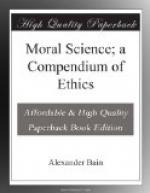’We thus see that a complete body of ethics should embrace two codes, two systems of rules, the one of which we may call the fundamental or antecedent, or under-ground ethics, as underlying the other; and the other of which we may call the upper or subsequent, or above-ground ethics, as resting on, and modified by the former. The under-ground ethics would inculcate on man the necessity of being what he truly is, namely, a creature of reason and of thought; in short, the necessity of being a man, and of preserving to himself this status. Here the end is virtue, that is, the life and health of the soul, and nothing but this. The above-ground ethics would inculcate on man the necessity of being a happy man.
It is not enough for man to be; he must, moreover, if possible, be happy. The fundamental ethics look merely to his being, i.e., his being rational; the upper ethics look principally to his being happy, but they are bound to take care that in all his happiness he does nothing to violate his rationality, the health and virtue of the soul.’
HENRY LONGUEVILLE/MANSEL.
Mr. Mansel, in his ‘Metaphysics,’ has examined the question of a moral standard, and the nature of the moral faculty, accepting, with slight and unimportant modifications, the current theory of a moral sense.
1. The Moral Faculty. That the conceptions of right and wrong are sui generis, is proved (1) by the fact that in all languages there are distinct terms for ‘right’ and ‘agreeable;’ (2) by the testimony of consciousness; and (3) by the mutual inconsistencies of the antagonists of a moral sense. The moral faculty is not identical with Reason; for the understanding contributes to truth only one of its elements, namely, the concept; in addition, the concept must agree with the fact as presented in intuition. The moral sense is usually supposed to involve the perception of qualities only in so far as they are pleasing or displeasing. To this representation Mr. Mansel objects. In an act of moral consciousness two things are involved: a perception or judgment, and a sentiment or feeling. But the judgment itself may be farther divided into two parts: ’the one, an individual fact, presented now and here; the other, a general law, valid always and everywhere.’ This is the distinction between presentative and representative Knowledge. In every act of consciousness there is some individual fact presented, and an operation of the understanding. ’A conscious act of pure moral sense, like a conscious act of pure physical sense, if it ever takes place at all, takes place at a time of which we have no remembrance, and of which we can give no account.’ The intuitive element may be called conscience; the representing element is the understanding. On another point he differs from the ordinary theory. It is commonly said that we immediately perceive the moral




